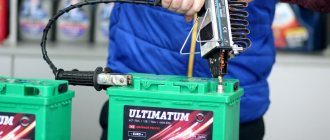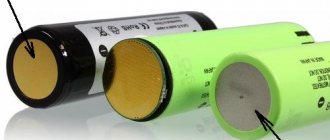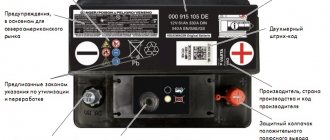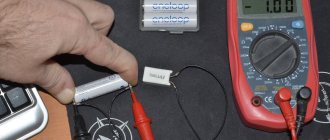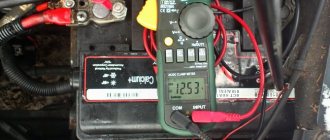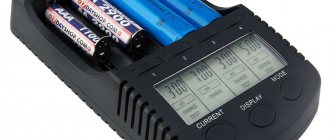A lack of charge in a car battery may be an indicator of problems with the generator or lack of timely recharging. When this indicator drops to critically low values, there is a risk that the car will “freeze” and the owner will not be able to start it. Therefore, a car enthusiast should be able to determine the battery charge by voltage; a table of indicators can help him with this.
It is important to measure the car battery voltage.
Battery charging voltage with car charger
If the car owner drives mainly long distances, the battery manages to replenish most of the charge from the generator during the run. The degree of charge is assessed by the indicator on the terminals: the higher the indicator, the more electrolyte.
The battery capacity is replenished using a charger operating on the conversion principle. Batteries can be classified according to a number of criteria. For example, they can be maintained or unattended and use different chemical agents (gel, lithium, etc.).
For different types, the process parameters (duration and voltage) will vary. On sale you can find chargers equipped with several modes for different types of batteries.
You can evaluate the degree of charge using a multimeter (by setting the voltage measurement mode) or a voltmeter. The ends of the wires are applied to the terminals. Since in this case only the number is important, it is not necessary to monitor the polarity. If the user confuses the red and black wires, the device will simply show a negative value, but in modulus it will correspond to the desired one.
The optimal charge level is indicated by indicators in the range from 12 to 16 Volts. When the number drops below 12, you should not use the battery - lead sulfate will settle on its plates, and this leads to a decrease in capacity and deterioration in performance. A deep discharge of the battery (a drop below 10.8) can lead to failure.
A little theory
First you need to understand what functions the battery performs:
- Starts the engine. Namely, it provides energy (spark) for ignition and rotates the starter motor. Well, and, of course, in modern car models it provides power to all electronics. If the battery is completely discharged or absent, the engine cannot be started at all;
- When the engine is not running, it powers all electronics (dimensions, electrical equipment, etc.);
- Performs auxiliary functions for the generator when the load on it is too heavy.
As you can see, the role of this part in the design of any machine is very significant. For this reason, the battery must not only be charged in a timely manner (especially for those who travel short distances), but also its performance must be regularly checked. In this case, it will be able to last much longer, and the driver will be able to avoid many problems on the road.
Voltage at battery terminals when charging
The battery is powered from the charger using a program with a constant voltage or current. When it is charging, you need to measure the data on the clamps. Measurements are performed only with the engine running. The optimum is 13-14 V. If it is high, the battery needs to be recharged; if it is low, there is a problem with the generator or the battery is depleting its resource.
With the engine turned off, it is not possible to diagnose the battery, but you can estimate the battery charge.
If the number is in the range of 12-14 V, there is no need to worry.
If it is lower, you need to check:
- transparency and electrolyte level;
- presence of deposits on the plates;
- the ability to recharge the battery to normal condition.
Under load and no load
Even at low voltage, the battery is quite capable of starting the engine. The main thing is that after this the generator ensures that the battery is charged. When the engine starts, the battery supplies a large current to the starter, thereby sharply losing charge. If the battery is in good condition, the charge is gradually restored to normal values within 5 seconds.
The voltage on a new battery should be between 12.6 - 12.9V, but these values do not always indicate the actual condition of the battery. For example, at rest, without connected consumers, the voltage is within normal limits, but under load it drops sharply and the charge is quickly consumed. This could happen.
Checking the battery with a load fork
That is why measurements are carried out under load. To do this, use a device such as a load fork. This test shows whether the battery holds a charge or not.
The plug consists of a voltmeter, contact probes and a load spiral in the housing. The device creates a current resistance twice the battery capacity, simulating inrush current. For example, if the battery capacity is 50A*h, then the device loads the battery up to 100A. The main thing is to choose the right resistance. If you exceed 100A, you will need to connect two resistance spirals to get accurate data.
Load measurements are carried out with a fully charged battery. The device is held for 5 seconds, then the results are recorded. Under load the voltage drops. If the battery is working properly, it will drop to 10 Volts and will gradually recover to 12.4 V and higher. If the voltage drops to 9V or lower, the battery does not hold a charge and is faulty. Although after charging it may show normal values - 12.4 V or higher.
Charging a battery with constant resistance
If you set the resistance to a constant, the voltage or current will take variable values. But the resistance inside a car battery is always a variable value, which is influenced by a number of factors: electrolyte saturation, state of charge, temperature. The total value is the sum of two: polarization resistance (not a constant value) and ohmic (constant for a battery).
Since resistance is an unstable quantity depending on the state of the battery, voltage, current, or a combination of both can be taken as a constant. The ballast resistance smoothes the charging flow.
What does the voltage indicator depend on?
There are several reasons why the battery voltage drops to a minimum:
Check for current leakage.
- natural wear and tear, when the battery has exhausted its life and is not able to maintain normal voltage values, like a new one;
- breakdown of the car's generator - as a result, when the engine is running, the IP does not receive the maximum charge necessary to restore capacity;
- current leakage in the vehicle's on-board network. In this case, even a new battery will not charge normally and will not be able to produce the operating starting current required for the starter. The cause of the leak can be any electrical equipment connected to a single network.
All causes of voltage drop, except for natural wear and tear, can be eliminated; just visit an electrician.
Sometimes the reason for battery discharge is frequent short-term trips, for example, when the place of work is 3-5 km from home. In this case, the generator may not have time to restore capacity. The solution is regular trips (once a week) lasting 30-40 minutes or recharging using a recovery device. Also, the voltage will drop if you do not turn off the lights or listen to the radio for a long time. Even one electrical appliance turned on with the engine off will completely drain the battery in a few hours.
Overcharging the battery when the maximum value exceeds 13 V is also dangerous. As a rule, the reason is a malfunction of the generator. Sometimes drivers deliberately overcharge the battery to increase the density of the electrolyte. If the voltage is higher than normal, the power supply resource is reduced.
Among the reasons for overcharging a car:
- malfunction of the relay that turns off the generator when the battery is fully charged;
- generator breakdown;
- incorrect choice of battery charger.
After eliminating the cause, the voltage should level out, which is determined by repeated measurements.
What voltage should I set when charging the battery?
Determining the battery charge level.
The charging parameter is always set to exceed the battery charge level. The more pronounced the difference, the sooner the battery will charge to the desired level.
This difference also affects the completeness of charging, and the ratio looks like this:
- to charge a 12 V battery, you will need to set the level to 16-16.5 V (then the battery will be fully charged);
- when using a value of 15 V, the battery can be filled to 85-88%;
- a parameter of 14.5 V gives 77-80% charge.
When the indicator at the battery terminals reaches 14.5 V, the device will notify you with a signal that charging is complete. Since this level does not provoke the release of gases when recharging the battery and after its completion, after some time of operation of the machine, the generator will limit the indicator to this figure.
Maximum battery charging voltage
The highest value used on the charger when recharging the battery is 16.5 V. Setting it will allow the battery to quickly reach its maximum capacity. However, it is not advisable to use such a voltage for all batteries. Calcium maintenance-free products are designed for it, capable of withstanding intense power supply with the accompanying boiling of the electrolyte.
Battery voltage at the end of charging
When the charging process is completed, after some time the electrolyte begins to dissociate, fill the pores of the plates and adapt to the temperature of the environment, which is why the charge level changes slightly. In hot weather it rises; when the air temperature is below zero, it falls.
To find out the final voltage, you need to measure it at the terminals with the motor turned on. If the indicator on a running car after charging begins to drop sharply, you need to diagnose the condition of the generator or replace the battery.
Table for determining the degree of charge of a car battery by voltage
You can determine the level of discharge of a car battery using the battery charge table. To do this, you need to measure the potential difference across the terminals and look at the charge level as a percentage according to the table below.
Determined by electrolyte density
The electrolyte contains sulfuric acid and distilled water. Pure sulfuric acid dissolves metals. Therefore, so that it cannot damage the lead plates, it is diluted with water. But if there is too much water, chemical reactions will become difficult.
Since the densities of water and acid are different, the ratio of components in the electrolyte can be estimated from the density. If it is higher than normal, it means there is more acid than required. Accordingly, the decomposition of lead plates occurs faster. The optimal density is 1.27 g/ml.
The density of the electrolyte depends on temperature. The lower the temperature, the lower the density.
The vehicle will not be driven under ideal conditions all the time. It can be used for short distance trips. In this case, the engine often starts, but does not have time to restore the charge. In this case, accelerated sulfation of the lead plates will occur, as a result of which the density of the electrolyte will decrease.
If you constantly drive your car over long distances, the battery may overcharge. As a result, the electrolyte will boil, the concentration of water in it will decrease, and the density will increase.
In each of these cases, the voltage on the battery will not correspond to the battery charge level. Therefore, in order to fully control the condition of the battery, you need to regularly measure the electrolyte density using the method in this article.
How to measure battery voltage
The easiest way to determine the battery charge level is by voltage. However, you must adhere to the following rules:
- Measurements can be taken 4-5 hours after charging, so that the parameters have time to stabilize;
- The battery must be disconnected from the load;
- If all conditions are met, you need to set the required measurement limit on the device and connect it to the battery terminals.
You can read about how to use a multimeter and check the battery with it here.
Reasons for discharge
The answer to the question why the battery discharged depends on the nuances of using the vehicle. The key reasons are:
- the battery life has come to an end;
- the generator in the car is faulty and leaks current;
- on-board electrical appliances are used too intensively, the power grid operates with excessive load;
- the driver left the car, forgetting to turn off the radio or side lights before leaving.
The above points should be kept under control. When buying a new battery, you need to check how charged it is. The accuracy of the result is important here, so several measurements are performed, with and without load. This requirement also applies to the situation of buying a used car. It is strongly not recommended to operate the vehicle without checking the charge level.
How long to charge a lead acid battery
The battery is perceived to be fully charged when the electrolyte begins to boil. The average charging time is usually 9 hours for standard batteries. But this indicator varies depending on the type of battery and its charge level at the time the charging process begins.
It is not recommended to recharge the battery, as this will cause scale to form on the lead plate. After which the battery may deteriorate beyond repair. In order to avoid this, you need to test the height of the electrolyte and its density before starting the process, especially in the cool season.
At high air temperatures, the battery is charged at a capacity reading of 50%; at colder temperatures, this figure is usually 25%.
The battery should be cleaned of dirt, dust and scale not only before charging, but also after, since traces of acid may remain on the surface during the charging process.
You can clean the battery with soap or soda solution. This procedure should be carried out with gloves for safety reasons. At the same time, try not to let the solution leak into the battery jars.
The whole process is quite simple, and if you follow all the instructions, the battery will last a long time and work well.
New MAX30205 sensor for accurate body temperature measurement
Maxim Integrated the MAX30205 digital temperature sensor for medical and fitness applications. The new sensor's built-in sigma-delta ADC provides an accuracy of better than 0.1°C in the temperature range of 37...39°C. Thanks to the 16-bit resolution, it is possible to record temperature changes of only 0.0039°C. In addition to measuring temperature, the new sensor can signal when a pre-recorded threshold value has been exceeded. The MAX30205 operates over a digital serial I²C interface with bus blocking protection and is controlled using standard read-write operations. Three additional address lines allow multiple sensors to operate on the same bus. Since these lines can be connected not only to ground and power, the total number of sensors can reach 32. An interesting feature of the microcircuit is a special separate output for a temperature comparator. The output signal (open drain) appears when the temperature exceeds the threshold value recorded in the TOS register. When the temperature drops below the value specified by the THYST register, the output is turned off and operates in thermostat mode. This output can be used to turn on the cooling fan, sound an alarm, or crash the system. The temperature comparator output can also operate in interrupt signal generation mode. In this case, the output value is fixed (the output is enabled) before the read operation of any register is performed on the I²C bus. The operating voltage range of the sensor is 2.7…3.6 V. In this case, the consumption does not exceed 600 μA. The microcircuit is produced in an 8-pin TDFN package and has an operating temperature range of 0...50°C.
•••
Useful tips
Recommendations that will be useful during operation and maintenance of the battery to extend its operating time:
- test the battery from time to time and recharge it from the mains as often as possible (at least once a quarter);
- Make sure that the generator, wires, and car voltage regulation functions are in good condition to ensure the battery is properly charged while traveling;
- measure current leakage;
- measure the density of the electrolyte substance after full charging, compare the numbers from the table above, correct the situation if necessary;
- Keep your car battery clean to minimize leakage current.
Do not short-circuit the output terminals of a car battery, as the consequences in this case will be disastrous.
Recommendations for choosing the version of ModelGauge for a specific application
Each version of ModelGauge has its own advantages (Table 1). The choice of algorithm implementation should be made taking into account the requirements of a particular application.
Table 1. Comparison of ModelGauge technology versions
| Parameter | Options | |||
| MAX17048/MAX17049 | MAX17047/MAX17050 | MAX172x1х | MAX172x5x | |
| Method of measurement | ModelGauge | ModelGauge m3 | ModelGauge m5 | ModelGauge m5 |
| Current consumption, µA | 3 | 25 | 9 | 12 |
| Dimensions of the microcircuit, mm | 0,9×1,7 | 1,5×1,5 | 1,6×2,34 | 1,6×2,34 |
| Shunt resistor | Not required | Required | Printed conductor required or used | Printed conductor required or used |
| Temperature measurement | Implemented by a microcontroller | Carried out using an external thermistor or microcontroller | Built-in sensor + external thermistor | Built-in sensor + external thermistor |
| Non-volatile memory | – | – | Eat | Eat |
| Accounting for aging and the number of charge-discharge cycles | – | – | Eat | Eat |
| Built-in EZ model | – | – | Eat | Eat |
| Authentication | – | – | SHA-256 | SHA-256 |
| Configuration support | 1S, 2S (MAX17049) | 1S | 1S | up to 15S; with balancing: 2S, 3S |
Let's look at examples of typical requirements.
Simplicity of circuit implementation. If this requirement is the main one, and high accuracy indicators remain in the background, then it is worth using microcircuits that support the initial version of the ModelGauge algorithm. For example, the MAX17048/MAX17049 monitors require only one external capacitor (Figure 8). It is worth remembering that to configure these microcircuits, a microcontroller is required, which must independently measure temperature and send data to the MAX17048/MAX17049 via the I2C interface.
Rice. 8. Connection diagram MAX17048/MAX17049
High accuracy and ease of implementation. If you need to get a low SOC measurement error, and also not waste time on studying battery characteristics, then the ModelGauge m5 EZ would be the ideal choice. This algorithm is supported by members of the MAX172xx .
Maximum accuracy. Maximum accuracy is ensured by microcircuits with ModelGauge m3/m5. At the same time, the MAX17047/MAX17050 with ModelGauge m3 do not count charge-discharge cycles, and the microcontroller must take over this function. To measure temperature, microcircuits require an additional thermistor.
ModelGauge m5 can independently count charge-discharge cycles and includes a temperature sensor. To increase the measurement accuracy, it is possible to connect a pair of additional external thermistors.
Minimum consumption. If you need to strictly save battery resources, you should use MAX17048/MAX17049 chips with ModelGauge. Their consumption is only 3 µA. The typical supply current for ModelGauge m5 is 9 µA. The ModelGauge m3 has the most significant consumption – up to 25 µA.
Minimum overall dimensions. In this case, the ideal choice again would be the MAX17048/MAX17049 chips with ModelGauge, since they require only one external capacitor, and their own dimensions are only 0.9x1.7 mm.
Reliability and protection from unlicensed batteries. Only MAX172xx monitors with ModelGauge m5 technology have built-in support for the SHA-256 hashing function. It allows you to recognize licensed batteries and inform the processor about the use of “non-standard” batteries.
Supports batteries with more than two cells. Only the MAX172x5 with ModelGauge m5 technology can boast of this feature. When using them, the number of batteries connected in series can reach 15 pieces.
MAX172xx chips with ModelGauge m5 technology are the most advanced representatives in the range of voltage monitors produced by Maxim Integrated. Let's take a closer look at them.


